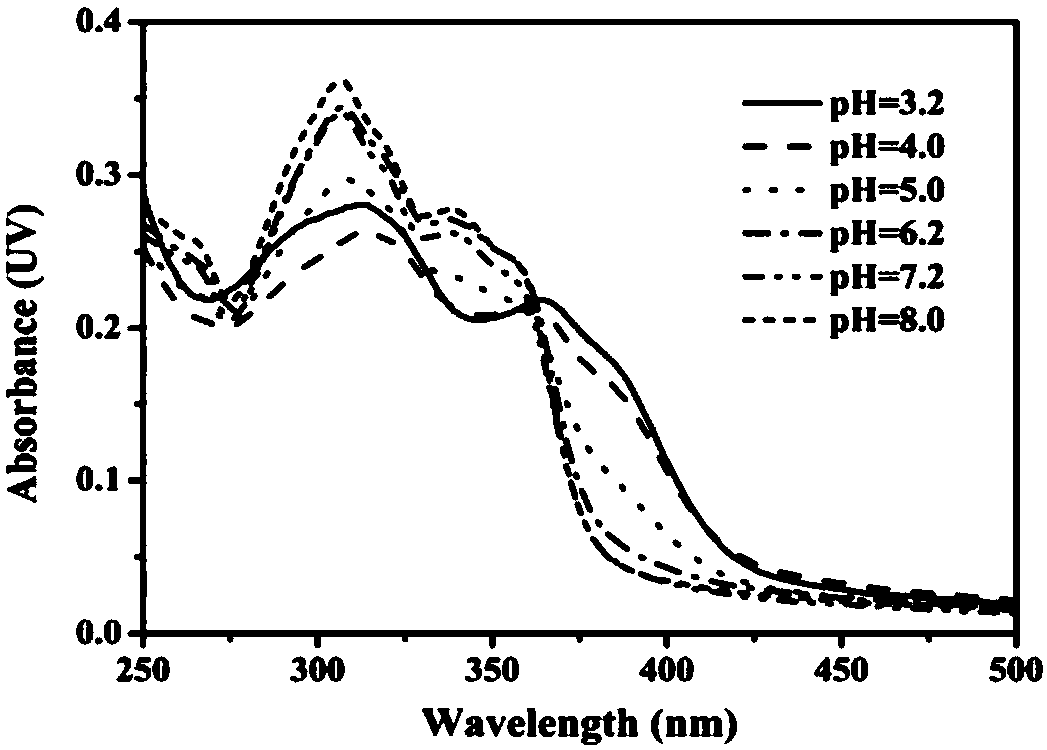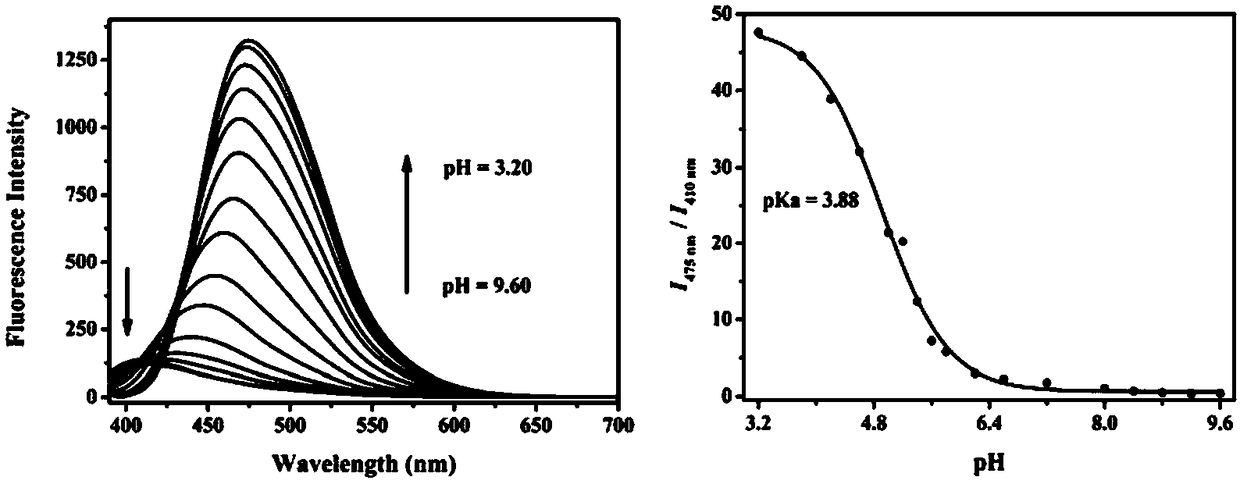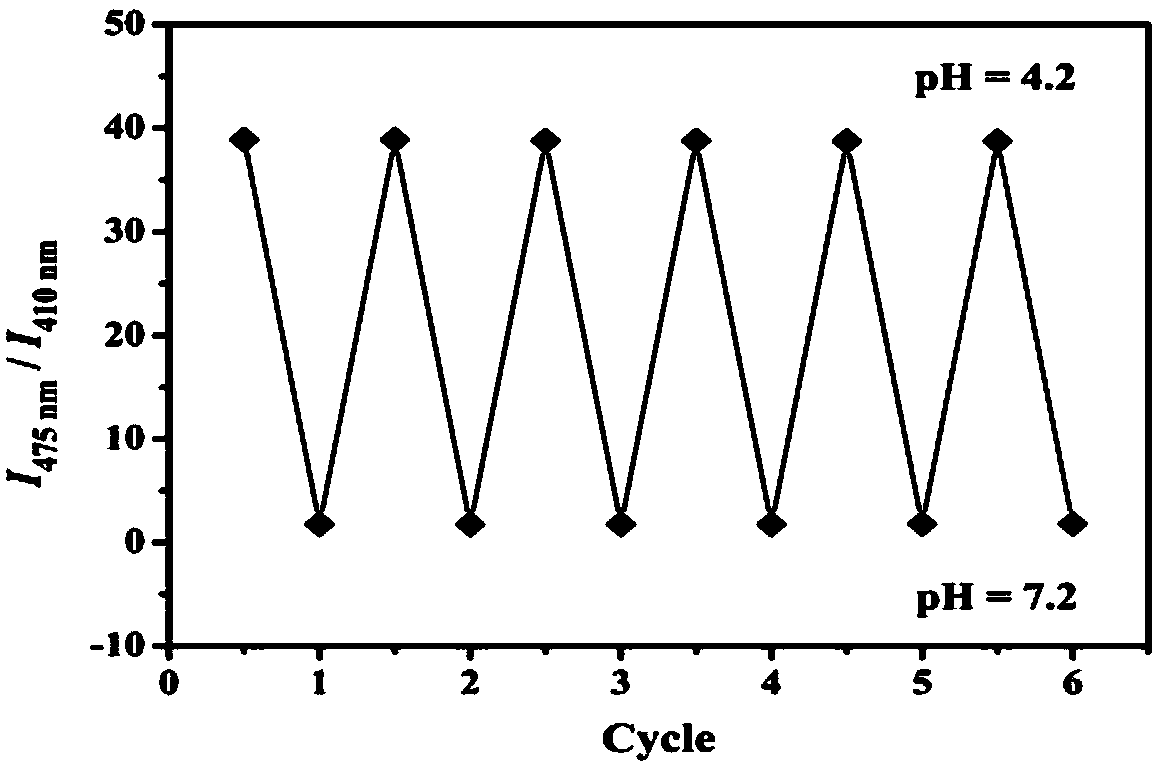Two-photon pH (potential of hydrogen) ratio measurement fluorescence probe for monitoring cell autophagy, preparation method of fluorescence probe and application
A fluorescent probe and two-photon technology, applied in the field of two-photon ratio fluorescent probes, can solve the problems of inability to monitor autophagy state, unsatisfactory visualization effect, etc., and achieve the effects of simple structure, good permeability and sensitive response.
- Summary
- Abstract
- Description
- Claims
- Application Information
AI Technical Summary
Benefits of technology
Problems solved by technology
Method used
Image
Examples
Embodiment 1
[0029] Embodiment 1: the synthesis of fluorescent probe molecule Lyso-MPCB
[0030] Add 1g of compound A, 0.46g of o-phenylenediamine, 0.0082g of p-toluenesulfonic acid and 30mL of N,N-dimethylformamide into a three-necked flask, heat up to 120°C in an oil bath, and protect the reaction with argon for 12h After the reaction is finished, the liquid is spin-dried, extracted with dichloromethane and water, and the upper organic phase is collected and spin-dried to obtain the crude product; the crude product sample preparation is separated by column chromatography to obtain the target product and obtain the target product 0.7g (1.28mmoL), yield 60%. The structural formula of the compound A is:
[0031]
[0032] 1 H NMR (400MHz, DMSO-d 6)δ12.84(s,1H),9.04(s,1H),8.41(s,1H),8.33(d,J=8.6Hz,1H),7.84(d,J=8.7Hz,1H),7.73( d,J=8.5Hz,1H),7.65(d,J=8.5Hz,2H),7.55(t,J=11.5Hz,3H),7.20(dd,J=5.5,2.6Hz,2H),7.02( d,J=8.3Hz,2H),4.49(t,J=7.0Hz,2H),3.82(s,3H),3.53(s,4H),2.30(s,6H),1.89-1.79(m,...
Embodiment 2
[0033] Embodiment 2: Fluorescence test and two-photon test of fluorescent probe molecule
[0034] Dissolve the fluorescent probe Lyso-MPCB of the present invention in DMSO to prepare a 1mM mother solution, take 100 μL of the mother solution in a 10mL volumetric flask, and then use buffer solutions of different pH values (phosphoric acid-acetic acid-boric acid solution system, by adding 1mM hydrochloric acid or sodium hydroxide solution (adjusted to different pH values) to dilute to 10 μM. The excitation wavelengths of the single-photon and two-photon fluorescent probes are 370nm and 760nm respectively, and the fluorescence spectrum changes in the wavelength range of 390-700nm are detected. And through the I corresponding to different pH values 475nm / I 410nm The pKa value (3.88) of the probe was calculated.
[0035] Fluorescent probe Lyso-MPCB is in the test solution adjusted back and forth with 1mM hydrochloric acid and sodium hydroxide solution, when pH=4.2 and pH=7.2, ...
Embodiment 3
[0037] Example 3: Cytotoxicity Test
[0038] The MTT (3-(4,5-dimethylthiazole-2)-2,5-diphenyltetrazolium bromide) experiment was based on the reported articles to do some cytotoxicity tests. Add 0, 5, 10, 15, and 20 μM fluorescent probes to the same batch of cells, and the conditions are 37 ° C, 5% CO 2 Incubate in a cell incubator for 24 hours, according to the formula of cell viability: cell viability%=OD 570(样品) / OD 570(对照组) ×100, the cell survival rate can be calculated ( Figure 5 ). From Figure 5 We can see that when the concentration is 20 μM, the survival rate of the cells is about 90%, which shows that the fluorescent probe of the present invention has no toxic effect on the cells, so it can be used to detect the viscosity in the cells.
PUM
 Login to View More
Login to View More Abstract
Description
Claims
Application Information
 Login to View More
Login to View More - R&D
- Intellectual Property
- Life Sciences
- Materials
- Tech Scout
- Unparalleled Data Quality
- Higher Quality Content
- 60% Fewer Hallucinations
Browse by: Latest US Patents, China's latest patents, Technical Efficacy Thesaurus, Application Domain, Technology Topic, Popular Technical Reports.
© 2025 PatSnap. All rights reserved.Legal|Privacy policy|Modern Slavery Act Transparency Statement|Sitemap|About US| Contact US: help@patsnap.com



